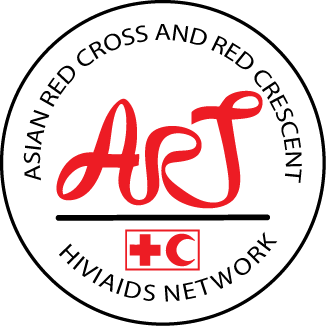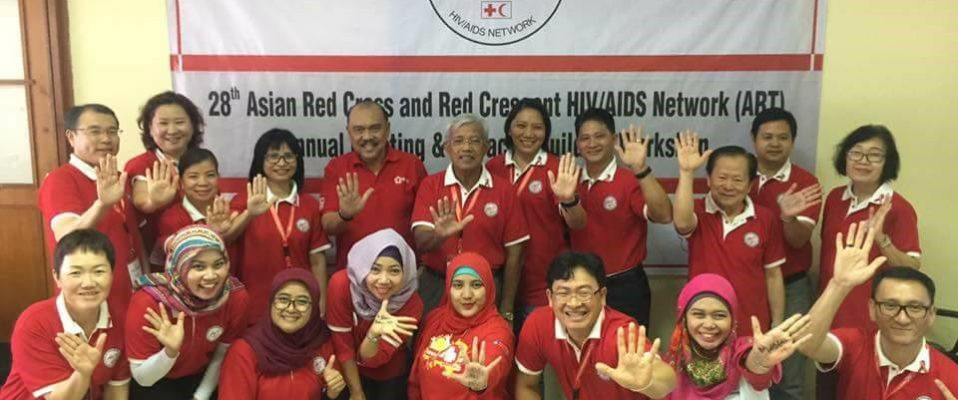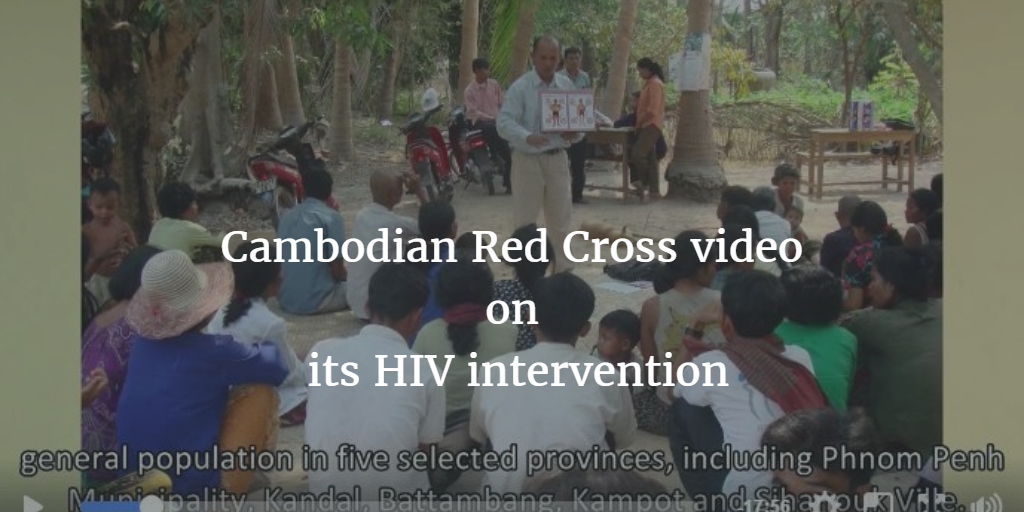ART assists to strengthen National Red Cross/Red Crescent Societies’ capacity to deliver and sustain scaled-up HIV programmes which seek to promote the respect of human rights in all aspects through the:
- Prevention of further HIV infections
- Expanding HIV care, treatment, and support
- Reducing HIV stigma and discrimination
ART collaborates and cooperates with the Federation and its representatives, Asia-Pacific Network of people living with HIV (PLHIV) (APN+) and other networks in responding to the requests and needs of National Societies in developing strategies and activities which focus on HIV and AIDS within the region.
The Federation Regional Delegation has a key role in supporting ART to ensure that their work remains in keeping with the overall aims and objectives of the Federation’s Global HIV strategy which also includes the Global Alliance on HIV and AIDS framework.
ART promotes National Societies participation in HIV activities by:
a) Providing a forum for the exchange and pooling of information, resources, ideas and experiences among National Societies
b) Providing capacity building opportunities for National Societies
c) Encouraging a positive environment within National Societies to establish and develop HIV programmes
d) Encouraging National Societies to contribute to their national HIV programmes
e) Advocating the Red Cross and Red Crescent commitments to HIV priorities
f) Facilitating National Societies access to financial and technical resources
ART ensures relevant inter-country collaboration on HIV issues by:
a) Monitoring training needs of National Societies and encouraging appropriate activities including workshops, study visits, exchange of information, materials and other resources
b) Promoting collaborative interventions on common issues on cross-border areas
c) Promoting inter-country interventions on common interests and issues among National Societies
- Brunei Red Crescent Society
- Cambodian Red Cross Society
- Hong Kong Red Cross Society
- Indonesian Red Cross Society
- Japanese Red Cross Society
- Lao Red Cross Society
- Malaysian Red Crescent
- Mongolian Red Cross Society
- Myanmar Red Cross Society
- Philippine Red Cross
- Vietnam Red Cross
- Red Cross Society of China
- Thai Red Cross
- The Republic of Korea National Red Cross
- Timor Leste Red Cross Society
- Australian Red Cross
- ART comprises of core members from National Societies in South East Asia and East Asia, and collaborating members from National Societies outside these regions.
- Membership of a National Society in ART is permanent as long as they meet their obligations as an ART member; however a National Society also retains the right to withdraw from the network if desired, by giving notice at an ART meeting or in writing to the ART Secretariat.
- ART representative must fulfill the obligations stated in Annexure 1: Roles and Responsibilities.
- The representative of the National Society will serve in ART for at least a term of two years; however it is desirable that the same representative continue to serve for several terms, where possible.
- If a representative does not meet these obligations or is unable to attend two consecutive ART annual meetings, the National Society should recommend another person who will serve the remainder of those terms and be considered for future terms.
- New members nominated by their National Society should submit their CV and a short statement demonstrating how they meet the selection criteria for ART members. This should include a comment on how they will feedback the lessons learned and decisions from ART meetings to the NS leadership.
- ART will comprise of HIV professionals and/or people directly involved in relevant activities within their National Societies HIV programmes. Only in exceptional circumstances – to be determined by the ART Management Team – will temporary substitutions be entertained.
- Every two years ART members will elect a Chairperson and Management Team at the Annual ART meeting. The Chair will serve for two calendar years. The Chair in collaboration with the ART Management Team will oversee ART planning activities, budget, direction/agenda setting and maintaining communication among ART members.
- Collaborating members are unable to take up ART Management Team or Chair positions and also are unable to vote for management team, chair and other related ART decisions.
- ART members contribute an annual membership fee of at least $1000 USD.
Network Officers (2016 – 2017):
Chairperson: Dr. Va Sopheak: Head, CD/NCD Sub Department – Cambodian Red Cross
Management Team Members:
- Yoshiteru Tsuji: Director, Development Cooperation Division, International Department – Japanese Red Cross Society
- Eka Wulan Cahyasari: Head of Public Health Subdivision, Health & Social Services Division – Indonesian Red Cross

Regional Meeting on Building Stronger TB and TB/HIV Community Partnerships for Advocacy in Asia and the Pacific | 23-25 January 2018 | Bangkok, Thailand
23 January , 2018 - 25 January , 2018143 on 143; 20 Days of Advocacy | 14 Nov – 3 Dec 2017 | Philippines
14 November , 2017 8:00 am - 3 December , 2017 5:00 pm UTC+7World AIDS Day by Thai Red Cross Society | 1 December 2016 | Thailand
1 December , 201628th Asian Red Cross and Red Crescent HIV/AIDS Network Meeting & Capacity Building Workshop | 29 November-2 December 2016 | Jakarta, Indonesia
29 November , 2016 8:00 am - 2 December , 2016 5:00 pm UTC+7Cambodian Red Cross celebrates World AIDS Day 2016
25 November , 2016 - 1 December , 2016
E-mail: Health Officer, Dr. Pornsak Khortwong (PK), at pornsak.khortwong@ifrc.org
Related videos
Guiding Documents
- Regional Cross Border Cooperation Project (Thailand, Cambodia, Lao PDR) on improving access to ARV among migrants living in Thailand – a presentation
- Philippine Red Cross HIV/AIDS Campaign
- Gender and HIV
- Youth volunteers supporting people with HIV/AIDS – Cambodia Red Cross Society – Siem Reap Branch
- Audio visual: Cambodian Red Cross cooperation with Australian Red Cross highlighting HIV programme
- Audio visual: AIDS and the impact on older people
- Lao Red Cross: Working in Partnership with People Living with HIV – Stories from the field
- Regional Cross Border Cooperation Project (Thailand, Cambodia, Lao PDR) on improving access to ARV among migrants living in Thailand – a presentation
- Philippine Red Cross HIV/AIDS Campaign
- Gender and HIV
- Youth volunteers supporting people with HIV/AIDS – Cambodia Red Cross Society – Siem Reap Branch
- Audio visual: Cambodian Red Cross cooperation with Australian Red Cross highlighting HIV programme
- Audio visual: AIDS and the impact on older people
- Lao Red Cross: Working in Partnership with People Living with HIV – Stories from the field
![]()







